基于OpenCV的图像卡通化
点击上方“小白学视觉”,选择加"星标"或“置顶”
重磅干货,第一时间送达
本期将创建一个类似于Adobe Lightroom的Web应用程序,使用OpenCV和Streamlit实现图像的卡通化

作为一个狂热的街头摄影爱好者,几乎每个周末都要在城市中拍摄一些照片,因此Adobe Lightroom始终是我们的首选软件,通过它可以编辑原始照片以使其更具“ Instagram风格”。
我们想能否创建一个自己的图像编辑软件?
开源计算机视觉库(如OpenCV)和开源应用程序框架(如Streamlit)的出现使这一想法得以实现。使用不到100行代码,我们就可以构建一个简单的图像卡通化Web应用程序,模仿Adobe Lightroom的功能。
我们通常需要执行两个主要步骤将图像转换为卡通图像:边缘检测和区域平滑。
边缘检测的主要目的显然是为了强调图像的边缘,因为卡通图像通常具有良好的边缘。同时,区域平滑的主要目的是消除颜色边界并减少图像的噪点,使图像像素化程度降低。
根据不同滤波器,我们可以获得不同的图像卡通化结果。在本文中,将有四个不同的过滤器:
接下来,我们将展示如何应用每个过滤器,以及从每个过滤器中获得什么样的结果。
使用“铅笔素描”滤波器,您的图像将被转换为素描,就像使用铅笔绘制图像一样。下面是使用OpenCV将图像转换为铅笔素描的完整代码。
# Convert the image into grayscale imagegray = cv2.cvtColor(img, cv2.COLOR_BGR2GRAY)# Blur the image using Gaussian Blurgray_blur = cv2.GaussianBlur(gray, (25, 25), 0)# Convert the image into pencil sketchcartoon = cv2.divide(gray, gray_blur, scale=250.0)
令人惊讶的是,使用OpenCV,我们只需三行代码就可以将图像转换成铅笔素描状的图片。现在让我逐行解释一下该图像发生了哪些变化。
在第一行中,我们使用OpenCV的cvtColor()功能将图像从彩色通道转换为灰度通道。这很简单,处理的结果是我们将图像变成了灰度图。
接下来,我们使用高斯模糊对图像进行模糊处理。模糊灰度图像,实际上是在平滑图像,减少图像的噪点。另外,模糊也是我们检测图像边缘的必要步骤。
模糊图像,可以使用OpenCV中的GaussianBlur()功能。我在GaussianBlur()函数中输入的(25,25)是内核的大小。
由于我们使用高斯模糊,因此内核中像素值的分布遵循正态分布。核数越大,标准偏差将越大,因此模糊效果越强。下面是内核大小不同时的模糊结果示例。
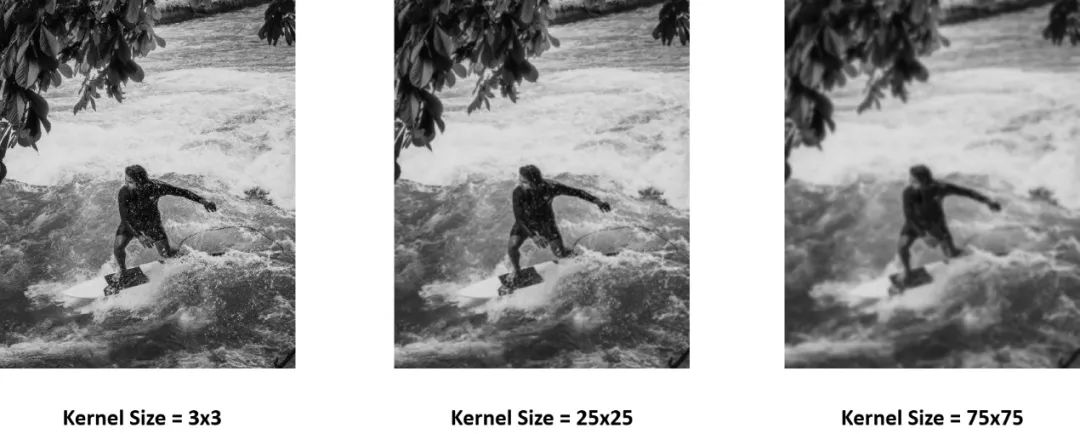
基于不同内核大小的模糊效果
最后一步是将原始灰度图像除以模糊后的灰度图像。这样可以得出两个图像中每个像素之间的变化率。模糊效果越强,每个像素的值相对于其原点的变化就越大,因此,它使我们的铅笔素描更加清晰。
以下是使用铅笔素描过滤器的结果。
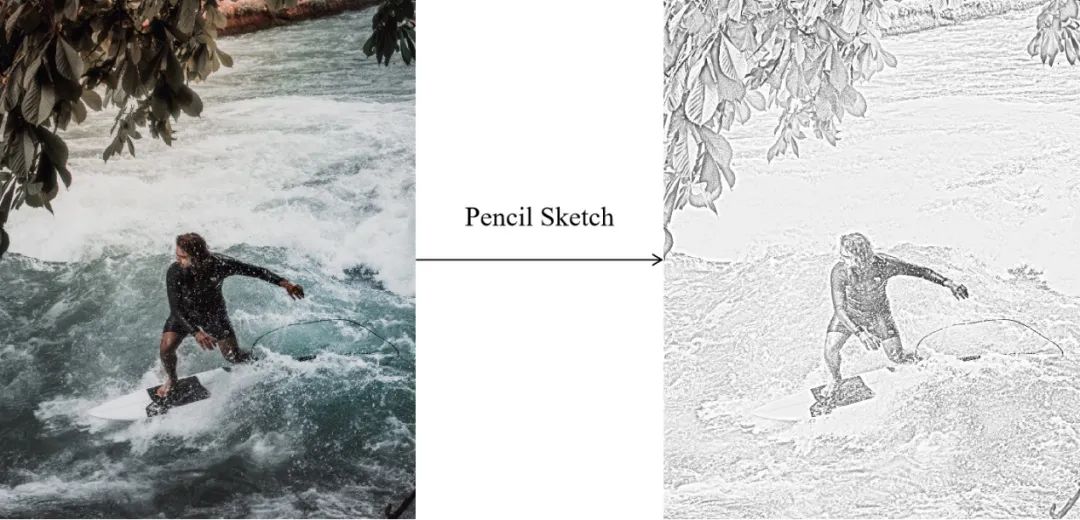
简而言之,“细节增强”滤镜通过锐化图像,平滑颜色以及增强边缘效果为我们提供了卡通效果。以下是使用此滤镜将您的图像转换成卡通的完整代码。
#convert the image into grayscale imagegray = cv2.cvtColor(img, cv2.COLOR_BGR2GRAY)#Blur the grayscale image with median blurgray_blur = cv2.medianBlur(gray, 3)#Apply adaptive thresholding to detect edgesedges = cv2.adaptiveThreshold(gray_blur, 255, cv2.ADAPTIVE_THRESH_MEAN_C, cv2.THRESH_BINARY, 9, 9)#Sharpen the imagecolor = cv2.detailEnhance(img, sigma_s=5, sigma_r=0.5)#Merge the colors of same images using "edges" as a maskcartoon = cv2.bitwise_and(color, color, mask=edges)
第一步与之前相同,我们需要将图像转换为灰度图像。
接下来,不使用高斯模糊,而是应用中值模糊。为此,我们使用OpenCV中的medianBlur() 函数。中值模糊通过计算与内核重叠的像素值的中值,然后将其中心像素替换为中值。但是,我们可以根据需要先使用高斯模糊。
接下来,我们需要检测图像的边缘。为此,将自适应阈值与OpenCV中的adaptiveThreshold() 函数一起应用。自适应阈值的主要目标是根据内核重叠的像素的平均值,将图像每个区域中的每个像素值转换为黑色或白色。
以下是自适应阈值对模糊图像的影响的可视化结果。
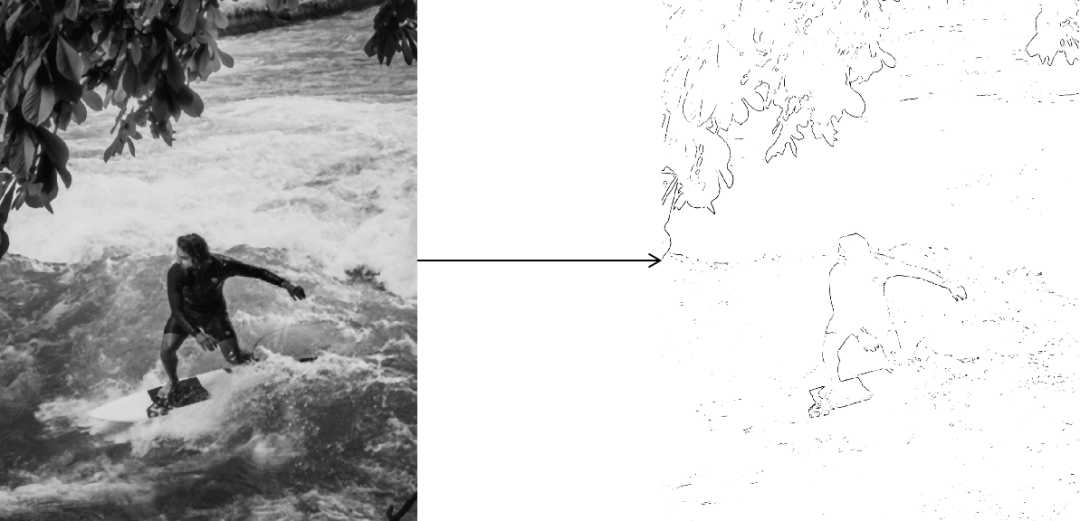
左:自适应阈值之前—右:自适应阈值之后
为了使图像看起来更清晰,我们可以使用OpenCV中的detailEnhance()函数。我们需要指定两个参数:
• sigma_s:控制着邻域的大小,该邻域的大小将被加权以替换图像中的像素值。值越高,邻域越大。这样可以使图像更平滑。
• sigma_r:如果要在平滑图像时保留边缘,这很重要。较小的值只会产生非常相似的颜色进行平均(即平滑),而相差很大的颜色将保持不变。
最后,我们使用自适应阈值的结果作为掩码。然后,根据蒙版的值合并细节增强的结果,以创建具有清晰边缘的清晰效果。
以下是“细节增强”过滤器的示例结果。
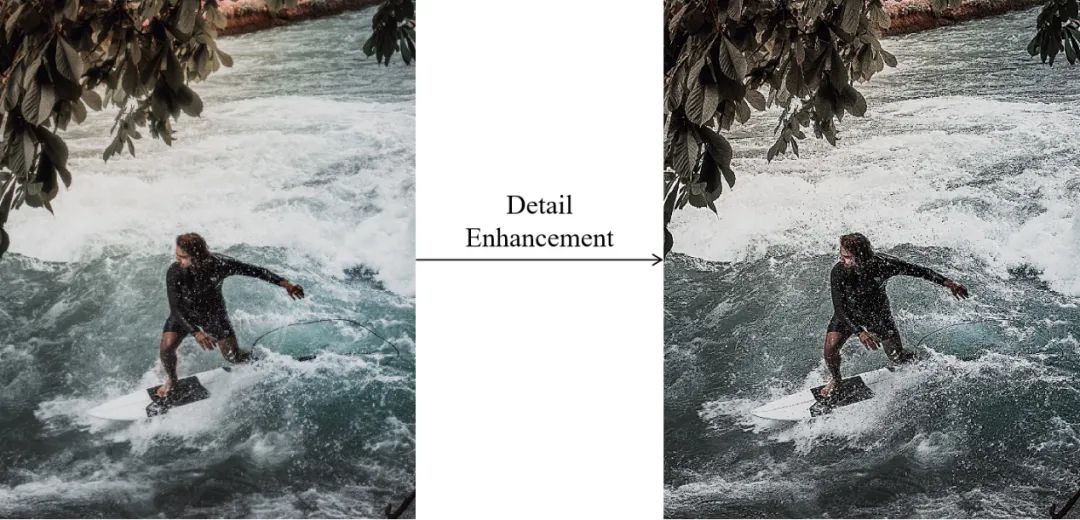
细节增强过滤器实现示例
双边过滤器
使用双边滤镜的一大优势是,我们可以在保留边缘的同时使图像和颜色平滑。以下是通过双边过滤将您的图像转换为卡通图像的完整代码。
#convert the image into grayscale imagegray = cv2.cvtColor(img, cv2.COLOR_BGR2GRAY)#Blur the grayscale image with median blurgray_blur = cv2.medianBlur(gray, 3)#Apply adaptive thresholding to detect edgesedges = cv2.adaptiveThreshold(gray_blur, 255, cv2.ADAPTIVE_THRESH_MEAN_C, cv2.THRESH_BINARY, 9, 9)#Sharpen the imagecolor = cv2.detailEnhance(img, sigma_s=5, sigma_r=0.5)#Merge the colors of same images using "edges" as a maskcartoon = cv2.bitwise_and(color, color, mask=edges)
如果仔细看,所有步骤都与“细节增强”过滤器中的步骤相似,但是这次不是使用detailEnhance() 函数,而是使用openCV中的bilateralFilter()函数。
调用此函数时需要传递的参数与detailEnhance()相同,只多一个附加参数,即内核大小d。首先,我们指定图像源,然后是d,sigma_s和sigma_r值控制平滑效果,并保持边缘。
以下是使用双边过滤器的结果示例。
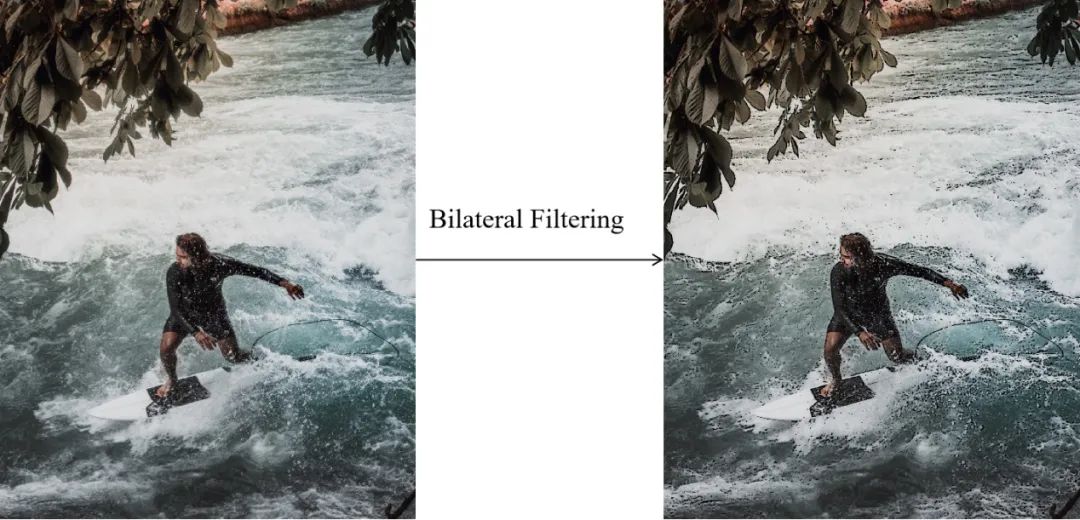
双边过滤器实施示例
铅笔边缘滤波器
铅笔边缘滤镜可创建仅包含重要边缘和白色背景的新图像。要应用此滤波器,下面是完整的代码。
#Convert the image into grayscale imagegray = cv2.cvtColor(img, cv2.COLOR_BGR2GRAY)#Blur the grayscale image using median blurgray = cv2.medianBlur(gray, 25)#Detect edges with Laplacianedges = cv2.Laplacian(gray, -1, ksize=3)#Invert the edgesedges_inv = 255-edges#Create a pencil edge sketchdummy, cartoon = cv2.threshold(edges_inv, 150, 255, cv2.THRESH_BINARY)
前两个步骤与其他过滤器相同。首先,我们将图像转换为灰度图像。接下来,我们使用大小为25的内核对图像进行模糊处理。
接下来,我们应用拉普拉斯滤波器来检测边缘。根据内核的大小,拉普拉斯滤波器中的值可以不同。
Laplacian滤波器的工作是,将通过对象内部的灰度级和图像背景强度来突出对象的边缘。以下是拉普拉斯滤波器应用结果。
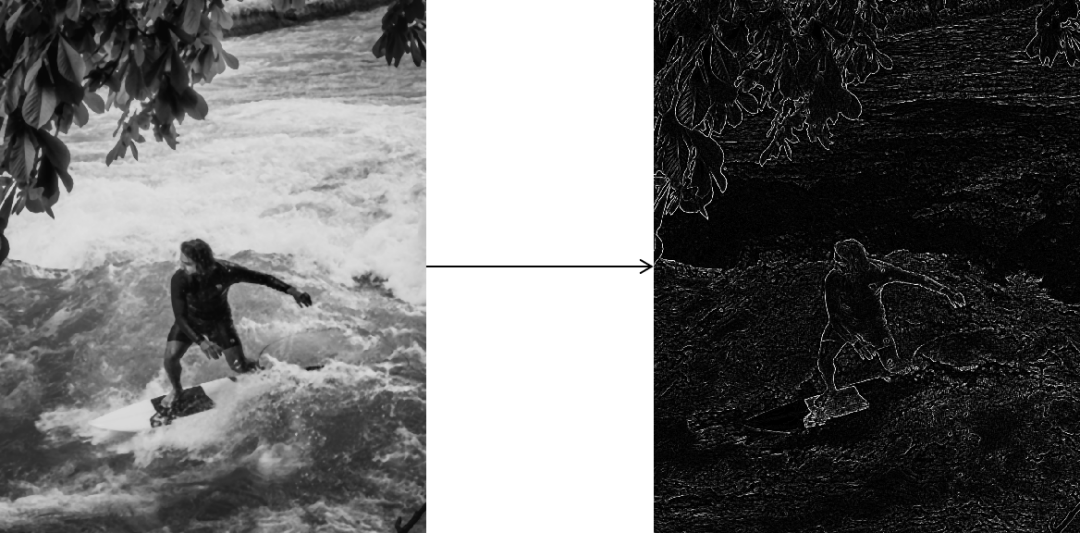
左:拉普拉斯滤波器应用之前—右:拉普拉斯滤波器应用之后
接下来,我们将Laplacian滤波器的结果求反。最后,通过应用openCV中的threshold()函数,根据指定的阈值将灰度图像转换为全黑或全白。
以下是“铅笔边缘”过滤器的结果示例。
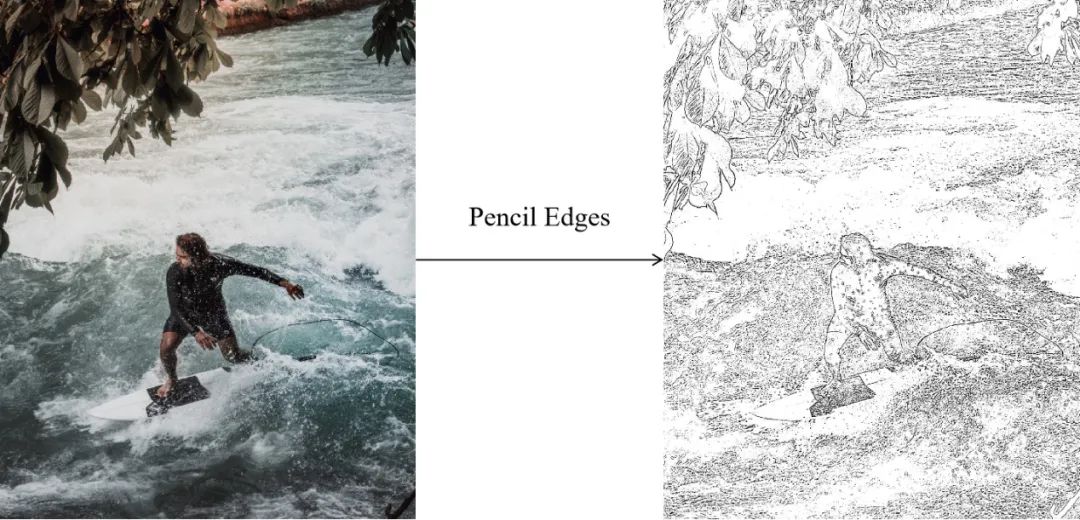
Pencil Edges滤镜实现示例
使用Streamlit构建图像卡通化Web应用程序
在创建了图像卡通化滤波器的代码之后,现在就可以创建图像卡通化Web应用程序了。
第一步,需要将创建图像卡通化滤波器的所有代码放入一个函数中,以便于访问。到目前为止,我们已经对每个参数值进行了硬编码,例如内核的大小等等。
现在,我们可以让用户使用滑块根据自己的喜好指定一个值,而不是对每个参数值进行硬编码。为此,我们可以使用Streamlit中的streamlit.slider()函数。下面是其实现的示例。
gray = cv2.cvtColor(img, cv2.COLOR_BGR2GRAY)scale_val = st.slider('Tune the brightness of your sketch (the higher the value, the brighter your sketch)', 0.0, 300.0, 250.0)kernel = st.slider('Tune the boldness of the edges of your sketch (the higher the value, the bolder the edges)', 1, 99, 25, step=2)gray_blur = cv2.GaussianBlur(gray, (kernel, kernel), 0)cartoon = cv2.divide(gray, gray_blur, scale= scale_val)
使用此滑块,可以创建一个交互式图像卡通化Web应用程序,就像Adobe Lightroom一样。每次调整内核的值和其他参数时,图像卡通化的结果都会实时更改和更新。
我们可以将其应用到streamlit.slider()上,创建的每个图像卡通化滤波器,以替换硬编码的参数值。
接下来,我们需要添加一个小插件,以便用户可以上传自己想要转换为卡通的图像。为此,我们可以使用Streamlit中的streamlit.file_uploader()函数。要添加某些文本到Web应用程序中,我们可以使用Streamlit 中的streamlit.text()或streamlit.write()。
用户上传图像后,现在我们需要显示图像,使用图像卡通化滤波器之一编辑图像,并显示卡通化图像,以便用户知道他们是否要进一步调整滑块。要显示图像,我们可以使用Streamlit中的streamlit.image()函数。
以下是在不到100行代码的情况下如何构建图像卡通化Web应用程序的实现。
import cv2import streamlit as stimport numpy as npfrom PIL import Imagedef cartoonization (img, cartoon):gray = cv2.cvtColor(img, cv2.COLOR_BGR2GRAY)if cartoon == "Pencil Sketch":value = st.sidebar.slider('Tune the brightness of your sketch (the higher the value, the brighter your sketch)', 0.0, 300.0, 250.0)kernel = st.sidebar.slider('Tune the boldness of the edges of your sketch (the higher the value, the bolder the edges)', 1, 99, 25, step=2)gray_blur = cv2.GaussianBlur(gray, (kernel, kernel), 0)cartoon = cv2.divide(gray, gray_blur, scale=value)if cartoon == "Detail Enhancement":smooth = st.sidebar.slider('Tune the smoothness level of the image (the higher the value, the smoother the image)', 3, 99, 5, step=2)kernel = st.sidebar.slider('Tune the sharpness of the image (the lower the value, the sharper it is)', 1, 21, 3, step =2)edge_preserve = st.sidebar.slider('Tune the color averaging effects (low: only similar colors will be smoothed, high: dissimilar color will be smoothed)', 0.0, 1.0, 0.5)gray = cv2.medianBlur(gray, kernel)edges = cv2.adaptiveThreshold(gray, 255, cv2.ADAPTIVE_THRESH_MEAN_C,cv2.THRESH_BINARY, 9, 9)color = cv2.detailEnhance(img, sigma_s=smooth, sigma_r=edge_preserve)cartoon = cv2.bitwise_and(color, color, mask=edges)if cartoon == "Pencil Edges":kernel = st.sidebar.slider('Tune the sharpness of the sketch (the lower the value, the sharper it is)', 1, 99, 25, step=2)laplacian_filter = st.sidebar.slider('Tune the edge detection power (the higher the value, the more powerful it is)', 3, 9, 3, step =2)noise_reduction = st.sidebar.slider('Tune the noise effects of your sketch (the higher the value, the noisier it is)', 10, 255, 150)gray = cv2.medianBlur(gray, kernel)edges = cv2.Laplacian(gray, -1, ksize=laplacian_filter)edges_inv = 255-edgesdummy, cartoon = cv2.threshold(edges_inv, noise_reduction, 255, cv2.THRESH_BINARY)if cartoon == "Bilateral Filter":smooth = st.sidebar.slider('Tune the smoothness level of the image (the higher the value, the smoother the image)', 3, 99, 5, step=2)kernel = st.sidebar.slider('Tune the sharpness of the image (the lower the value, the sharper it is)', 1, 21, 3, step =2)edge_preserve = st.sidebar.slider('Tune the color averaging effects (low: only similar colors will be smoothed, high: dissimilar color will be smoothed)', 1, 100, 50)gray = cv2.medianBlur(gray, kernel)edges = cv2.adaptiveThreshold(gray, 255, cv2.ADAPTIVE_THRESH_MEAN_C,cv2.THRESH_BINARY, 9, 9)color = cv2.bilateralFilter(img, smooth, edge_preserve, smooth)cartoon = cv2.bitwise_and(color, color, mask=edges)return cartoon###############################################################################st.write("""# Cartoonize Your Image!""")st.write("This is an app to turn your photos into cartoon")file = st.sidebar.file_uploader("Please upload an image file", type=["jpg", "png"])if file is None:st.text("You haven't uploaded an image file")else:image = Image.open(file)img = np.array(image)option = st.sidebar.selectbox('Which cartoon filters would you like to apply?',('Pencil Sketch', 'Detail Enhancement', 'Pencil Edges', 'Bilateral Filter'))st.text("Your original image")st.image(image, use_column_width=True)st.text("Your cartoonized image")cartoon = cartoonization(img, option)st.image(cartoon, use_column_width=True)
现在,可以打开提示符,然后转到包含上面代码的Python文件的工作目录。接下来,您需要使用以下命令运行代码。
streamlit run your_app_name.py最后,您可以在本地计算机上使用图像卡通化Web应用程序!以下是该网络应用程序的示例。
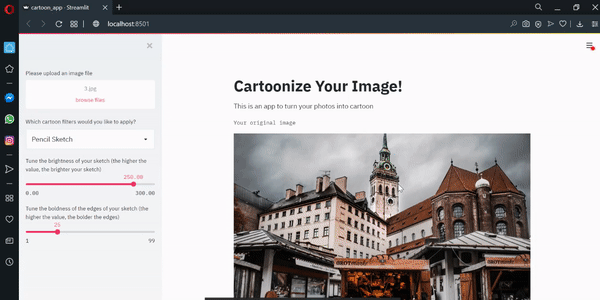
该网络应用程序示例
部署Web应用
本节是可选的,但是如果小伙伴需要部署Web应用程序以便其他人也可以访问您的Web应用程序,则可以使用Heroku部署Web应用程序。
要将Web应用程序部署到Heroku,首先要免费创建一个Heroku帐户,然后下载Heroku CLI。
接下来需要在与Python文件相同的目录中创建四个其他文件,它们是:
• requirements.txt:这是文本文件,用于告诉Heroku构建Web应用程序需要哪些依赖项。因为在我们的web应用程序,我们使用四种不同的库:opencv,numpy,Pillow,和streamlit,那么我们就可以写所有这些库及其版本为requirements.txt的
opencv-python==4.3.0.36streamlit==0.63.0Pillow==7.0.0numpy==1.18.1
• setup.sh:这是用于在Heroku上设置配置的文件。为此setup.sh文件编写以下内容。
mkdir -p ~/.streamlit/echo "\headless = true\n\port = $PORT\n\enableCORS = false\n\\n\> ~/.streamlit/config.toml
• Procfile:这是告诉Heroku哪些文件以及应如何执行文件的文件。为Procfile编写以下内容。
web: sh setup.sh && streamlit run cartoon_app.py• Aptfile:这是Heroku 构建包的文件,以使OpenCV能够在Heroku中运行。为Aptfile编写以下内容。
libsm6libxrender1libfontconfig1libice6
接下来,打开命令提示符,然后转到Python文件和这四个其他文件的工作目录。在其中键入heroku login命令,以便您登录到Heroku帐户。
现在,您可以通过键入来创建新应用heroku create your-app-name。为确保您位于新创建的应用程序内部,请键入以下内容:
heroku git:remote -a your-app-name接下来,我们需要在新创建的应用程序中添加一个buildpack,以使OpenCV能够在Heroku上运行。要添加必要的buildpack,请在Heroku CLI上键入以下内容。
heroku create --buildpack https://github.com/heroku/heroku-buildpack-apt.git现在设置好了。接下来,您需要通过打字来初始化一个空的git git init其次是git add .,git commit和git push heroku master命令。
git initgit add .git commit -m "Add your messages"git push heroku master
之后,部署过程就开始了,并且可能需要一些时间来等待此部署过程。最后,Heroku将生成新部署的Web应用程序的URL。
就是这样!现在,我们已经构建了自己的图像卡通化Web应用程序,该应用程序模仿了Adobe Lightroom的功能。
交流群
欢迎加入公众号读者群一起和同行交流,目前有SLAM、三维视觉、传感器、自动驾驶、计算摄影、检测、分割、识别、医学影像、GAN、算法竞赛等微信群(以后会逐渐细分),请扫描下面微信号加群,备注:”昵称+学校/公司+研究方向“,例如:”张三 + 上海交大 + 视觉SLAM“。请按照格式备注,否则不予通过。添加成功后会根据研究方向邀请进入相关微信群。请勿在群内发送广告,否则会请出群,谢谢理解~
